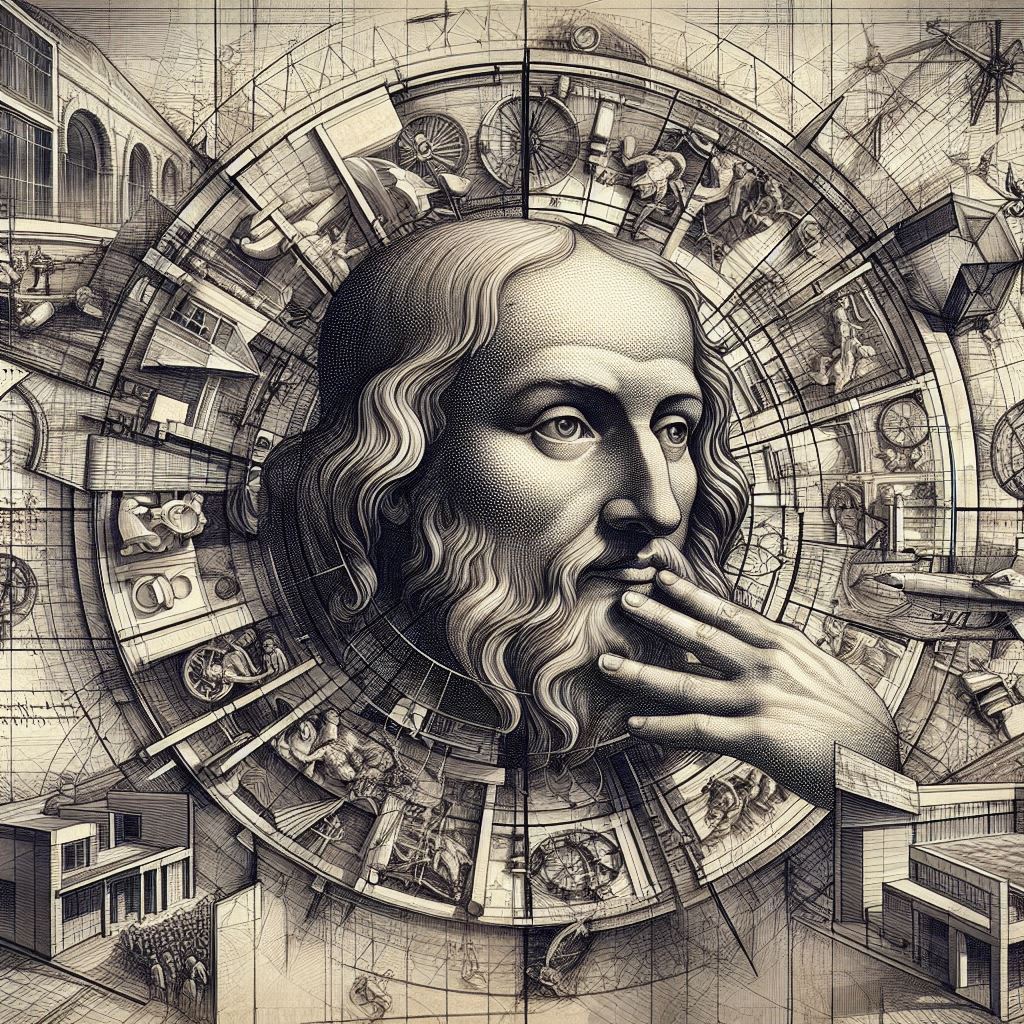Story details a significant historical moment—Leonardo da Vinci’s passing on May 2, 1519—and shows how the legacy of his interdisciplinary genius can inspire and transform an individual’s life today.
## I. At the Twilight of a Genius
On a mild spring morning in 1519 in the quiet town of Amboise, France, an extraordinary aura hung in the air. The gentle light of dawn filtered through narrow windows onto the modest chamber of Leonardo da Vinci, where the great polymath spent his final days. At the age of 67, Leonardo was a man who had long transcended the boundaries of art, science, and engineering—a soul for whom the pursuit of knowledge had been as natural as breathing. Yet even geniuses cannot defy mortality.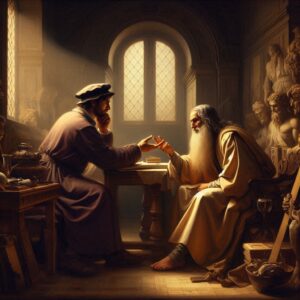
In the worn leather-bound journals scattered across his desk, Leonardo’s hand had traced ideas of flight, anatomy, and the mysteries of nature. Each page of his notebooks pulsed with his lifelong curiosity and determination to capture the beauty of the world in all its complexity. On this day—May 2, 1519—Leonardo sensed the approaching end, a bittersweet moment of reflection amid unfinished sketches and half-formed inventions. He had dedicated his life to pushing the limits of human thought, and now, with the autumn of his days drawing near, he prepared to leave behind a legacy that would spark countless revolutions of wonder in generations to come.
In the quiet solitude of his chamber, Leonardo’s mind wandered over memories of his youth on the Tuscan hills, of the flamboyant courts of Milan, and of the bustling streets of Florence. Moments of triumph—painting the mysteriously enigmatic “Mona Lisa,” sketching mechanical contraptions meant to defy gravity, or dissecting the anatomy of the human body with a scientific precision rarely seen in his era—flashed before his fading eyes. These recollections were paired with quiet regrets: there were inventions left uncompleted, and ideas that had only begun to bloom in the fertile soil of his imagination.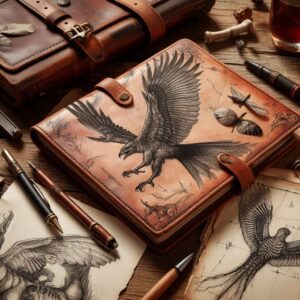
His trusted apprentice, Francesco Melzi, sat nearby in respectful silence. More than a pupil, Francesco was also a chronicler of Leonardo’s art of observation and wonder. In those final hours, Leonardo shared with him one last reflection:
> “Let these pages be a mirror of the soul’s yearning to know, to create, and to embrace the mystery of life. Though my body fades, let the spark of inquiry ignite the hearts of those who follow.”
And so, on that fateful morning, as gentle sighs of the wind mingled with the scratching of his quill, Leonardo da Vinci took his final breath. His departure marked not merely the end of a life, but the beginning of an eternal legacy—a beacon of creativity and interdisciplinary thinking that would continue to challenge minds centuries into the future.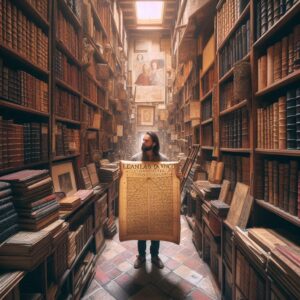
## II. The Legacy of a Renaissance Master
In the centuries that followed Leonardo’s death, his notebooks, filled with brilliant sketches and curious inventions, navigated the turbulent currents of history. Travelling through private collections and hidden libraries, these manuscripts came to symbolize human ingenuity. Their pages spoke in a language beyond words: a language of interwoven art and science, of beauty and mystery, of the endless pursuit of learning.
The ideas captured in those pages began to shape, in quiet yet profound ways, the very fabric of Western thought. Artists and architects turned to his sketches for insight into human anatomy and natural form; scientists regarded his studies as early explorations of principles that would eventually become the bedrock of modern engineering; even philosophers found in his musings a call to transcend disciplinary boundaries and seek unity within the diverse manifestations of knowledge.
Leonardo had shown that creativity was not confined to the canvas or the laboratory—it was a way of life. His interdisciplinary approach, an elegant synergy of art and science, became a timeless reminder that the world is best understood as a complex, interconnected tapestry. Over the years, his ideas spread far and wide, from the workshops of Northern Renaissance masters to the modern laboratories of robotics and artificial intelligence. In every field of inquiry, the call to “think without limits” resonated like an echo from a distant, golden age.
In crowded lecture halls and quiet studios across Europe and later the entire world, educators and innovators used Leonardo’s life as a touchstone. His notebooks encouraged students to combine rigorous observation with imaginative speculation—a paradigm that has come to be recognized as the very essence of a creative, problem-solving mind. Leonardo’s legacy became a kind of intellectual inheritance for countless generations, reminding them that there is always more to see beyond the obvious, more to create beyond the routine.
## III. A Modern Renaissance
Fast forward over 500 years to a bright spring day in 2025—a day that, like May 2 in 1519, holds the power to transform lives. In a bustling modern city, where glass towers and digital screens define the skyline, lives a man named Marco. An urban architect by trade and a painter by passion, Marco is a creative soul whose days are filled with the rigorous demands of modern design. Yet amid the precision of blueprints and the clamor of deadlines, he has come to feel that something essential is missing—a spark of creative freedom that seems forever elusive in the cacophony of modern routine.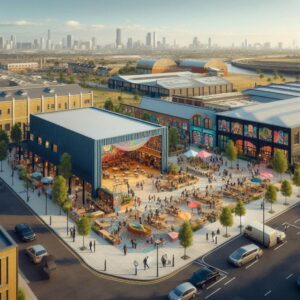
Marco’s life had always revolved around structured innovation. He thrived on technical perfection, leading teams to complete projects that were marvels of functionality and efficiency. But as deadlines loomed and the constant pressure to produce standardized results mounted, his inner world—filled with dreams of abstract brushstrokes and surreal landscapes—began to wither. In the quiet corners of his mind, Marco wondered if his vision, once boundless like the sky, was slowly being choked by the chains of modern obligations.
One rainy afternoon, while exploring an antique bookshop tucked away in a narrow side street of the city, Marco’s eyes landed on a fragile, leather-bound volume. Tucked between old journals and faded maps was a collection of manuscripts that bore the unmistakable hand of Leonardo da Vinci. The pages, though yellowed and delicate, were alive with sketches of flying machines, anatomical studies, and enigmatic geometric designs. With trembling fingers, Marco held the relic, feeling an inexplicable connection—as if the genius of a long-departed master was whispering a secret meant only for him.
In that moment, the world around Marco transformed. The steady patter of rain, the soft low hum of the old shop, and the faint scent of ancient paper combined to create a portal to a bygone era. He sat down on a worn velvet armchair and began to read, immersing himself in Leonardo’s observations and wild, visionary ideas. The text was not written in the precise language of modern textbooks but in a lyrical script that spoke directly to the soul—inviting its reader to see beyond the mundane, to explore the interconnected realms of art, science, and nature.
Marco became engrossed in the notebooks’ layers of meaning. He discovered a timeless message: that the greatest breakthroughs often occur at the intersection of diverse disciplines, when one dares to look at the world without the filters of convention. Leonardo’s sketches, replete with ideas that still seemed revolutionary, inspired Marco to reassess his own approach to creativity. They taught him that true innovation lies not in rigid specialization, but in the willingness to blend observation with imagination, to let curiosity override routine.
## IV. Reawakening the Creative Spirit
In the weeks that followed his discovery, Marco felt his world begin to change. Every morning, before the relentless buzz of commuter trains and early-morning emails interrupted his thoughts, he would rise early to practice quiet reflection inspired by Leonardo’s legacy. By a window overlooking the awakening city, Marco would settle with a cup of coffee and his treasured copy of the notebooks. In those moments of stillness, he allowed his mind to wander freely—to sketch, to write, to dream without limits.
Marco soon realized that Leonardo’s life was not only a record of breathtaking inventions and masterful art but also a guide for living with unbridled passion and creative integrity. Encouraged by this revelation, he began to experiment in his work. Instead of adhering strictly to conventional architectural blueprints, he started integrating imaginative elements inspired by Leonardo’s sketches. His designs began to incorporate fluid curves, unexpected spatial relationships, and integrating natural light in ways that lent his modern constructions an almost living quality. The transformation was subtle at first—a slight deviation in a line here, a creative twist on a façade there—but over time, his projects became renowned for their artistic depth and innovative spirit.
Marco’s newfound approach soon spilled over into his personal life as well. Once a man whose every moment was dominated by schedules and metrics, he gradually rediscovered the joys of spontaneous creativity. He enrolled in painting courses, sometimes spending entire weekends in the countryside, sketching the interplay of sunlight and shadow on ancient stone walls. The old passion that had been buried beneath layers of daily responsibility was now reawakened, nurtured by the lessons of a Renaissance genius whose ideas defied the eras.
A turning point came when Marco was invited to speak at a local creative conference. Standing before an audience of architects, artists, and entrepreneurs, he recounted the day he discovered Leonardo’s notebooks and how that serendipitous moment had reshaped his life. In his speech, Marco described the delicate balance between technical expertise and creative freedom—the marriage of precision and wild imagination that he had observed in Leonardo’s work. His words resonated deeply with those in attendance, many of whom, too, had felt the weight of routine stifling their innovation.
> “Leonardo taught us that every scribble, every sketch, every stray thought is a spark of potential,” Marco said. “What he left behind is not just a collection of drawings and notes—it is an invitation to see the world anew. If we allow ourselves to be curious, to blend purpose with passion, we can transform our work, our communities, and ultimately our lives.”
Inspired by Marco’s insights, several young creatives approached him after the conference. They were eager to learn how he had managed to break free from the confines of conventional thinking and find inspiration in the echoes of the past. Over time, Marco took on the role of mentor, guiding a new generation of urban planners, designers, and innovators who were determined to embrace creativity as a way of life.
## V. The Ripple Effect: Transforming a Community
Marco’s personal renaissance had effects beyond his own transformation. Motivated to pass on the lessons he had learned, he spearheaded a project to revitalize a neglected neighborhood in his city. The district, long abandoned by conventional developers, held a peculiar charm—its narrow lanes, faded murals, and old stone buildings spoke of a time when creativity and local culture thrived.
In collaboration with community leaders, local artists, and fellow architects, Marco proposed the creation of a cultural hub—a space designed as a canvas for the collective imagination. Drawing on the spirit of Leonardo’s innovative polymathy, the project was envisioned as an intersection where art met science, history merged with modernity, and every citizen was encouraged to contribute their own voice to the tapestry of community life.
Workshops were organized in local schools and community centers. Artists taught classes on free-form drawing and abstract painting; scientists led discussions on the relationship between form and function in nature; and architects shared insights on how design can echo the organic patterns found in the world around us. What emerged was more than an urban renewal project—it was a movement that celebrated the limitless potential of human creativity.
A public exhibition showcased innovative projects that reflected the interdisciplinary ethos Marco had adopted. Among the exhibits was a mural—a sweeping, vibrant canvas that depicted an amalgamation of Leonardo’s iconic sketches with modern abstracts. The mural, sprawling across a once-dull wall, quickly became a celebrated landmark in the neighborhood, a visible reminder that the ideals of the Renaissance were as relevant today as they were five centuries ago.
For the community, the transformation was palpable. Old relationships were rekindled, new friendships were forged, and a renewed sense of pride in local culture emerged. People began to frequent the newly opened studios and cafés that hosted poetry readings and art shows. Children, who once passed by empty lots with disinterest, now played in parks designed with whimsical, nature-inspired installations that invited them to explore and imagine.
Marco, now recognized as a visionary architect and cultural leader, often reflected on the irony of it all. The spark that had been set in motion by Leonardo’s fleeting final hours—when a man on the brink of departure chose to share his eternal curiosity—had traveled centuries to reignite hope and creativity in his own life and in the lives of an entire community. What had once been a somber moment of farewell had transformed into a living legacy of inspiration.
## VI. Lessons for the Individual Soul
As the years went by, Marco never lost sight of the personal insights gleaned from that chance encounter with Leonardo’s work. In every project he undertook and every new idea he nurtured, the lessons of embracing the unknown and celebrating the union of art and science remained at the core of his philosophy. For him, the legacy of Leonardo da Vinci was not a historical artifact locked in dusty pages; it was an active, ever-present force urging him—and all of us—to live with bold curiosity and fearless creativity.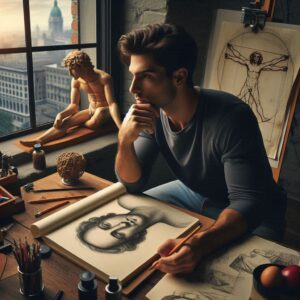
Reflecting on his journey, Marco identified several key lessons that he believed could benefit anyone feeling trapped by the monotony of daily routines:
- **Embrace the Interdisciplinary:**
Leonardo’s genius lay in his refusal to be boxed into one discipline. Whether you are an artist, an engineer, or simply someone seeking to enrich your perspective, allow yourself to explore diverse fields. Mix science with art, logic with imagination, and you’ll discover innovative solutions to everyday challenges.
- **Celebrate Imperfections:**
In his sketches, Leonardo captured the beauty of imperfection—the rough lines that hinted at creative spontaneity. Similarly, in life, it is often our mistakes and our unusual ideas that lead us to breakthrough moments.
- **Seek Quiet Moments:**
Amid the clamor of modern life, carving out moments of reflection can awaken the inner spark of creativity. Whether it’s in the early hours of the morning or during a solitary walk in nature, give yourself the space to dream without interruption.
- **Transform Challenges into Opportunities:**
Just as Leonardo’s final days were filled with both unfinished work and profound reflection, so too do our lives contain both challenges and untapped opportunities. Look at obstacles as invitations to innovate rather than as insurmountable barriers.
- **Inspire and Be Inspired:**
Marco’s transformation was amplified by sharing his journey with others. In every act of collaboration or mentorship lies the potential to create a ripple effect—a community uplifted by a collective spirit of exploration and mutual support.
For anyone feeling constrained by fine details and endless routine, the philosophy of Leonardo da Vinci offers a beacon. Embracing a holistic, curious approach to life may lead not only to personal creative breakthroughs but also to richer, more connected relationships with the world around you.
## VII. Epilogue: The Eternal Renaissance
The final sunset over Amboise in 1519 marked the end of Leonardo da Vinci’s earthly life, yet his spirit continued to echo across the centuries—a timeless call daring each generation to think differently. In Marco’s modern journey, we see that the power of that legacy remains undiminished. A chance encounter with ancient manuscripts awakened a dormant creativity, transforming a once-stifled existence into a vibrant tapestry of art, community, and personal growth.
Today, as you go about your own life, remember that history is not far away—it is all around you. The genius and passion of those who came before can serve as your guide, encouraging you to break free from preconceived limits and to pursue your dreams with unbridled enthusiasm. Embrace the interdisciplinary, the imperfect, and the unknown. Whether you are designing a building, writing a novel, or simply contemplating life in quiet solitude, let Leonardo’s spirit remind you that every challenge is ripe with possibility and that every moment is an invitation to create your unique masterpiece.
As the legacy of Leonardo da Vinci’s final days inspires modern creatives like Marco—and through him, countless others—it teaches us that the soul’s desire for knowledge and beauty is eternal. The creative fire kindled over five hundred years ago may seem distant in time, yet its light shines on today in every innovative thought, every bold idea, and every act of courageous exploration.
May you, too, discover your own renaissance—a personal journey where the lessons of the past illuminate the path to a future filled with wonder, connection, and limitless creativity.
*Echoes of Genius: Leonardo’s Last Breath and a Modern Renaissance*
is not merely a tale of history but a living testament to the idea that every life can be transformed by embracing the timeless spirit of exploration. Just as Leonardo da Vinci’s final reflections continue to inspire, so can your own journey be enriched by the courage to see the world anew. Embrace your inner genius, and let the echoes of the past guide you toward a brighter, more creative tomorrow.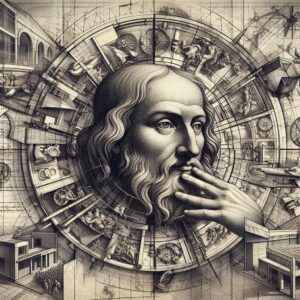
**In Conclusion**
On May 2, 1519, a brilliant mind exhaled its final breath—yet in that quiet farewell, Leonardo da Vinci left behind an eternal invitation to explore, to dream, and to create without limits. Today, let that legacy serve as a reminder: every moment holds the potential for transformation. May you find in your own life the courage to blend art with science, to see beauty in imperfection, and to transform challenges into stepping stones toward greatness. The Renaissance spirit is alive in you—waiting for you to unleash the power of your own genius.
This concludes **”Echoes of Genius: Leonardo’s Last Breath and a Modern Renaissance.”** May the story serve as both a tribute to one of history’s greatest minds and an inspiration for every individual ready to embrace the timeless art of creative living.

